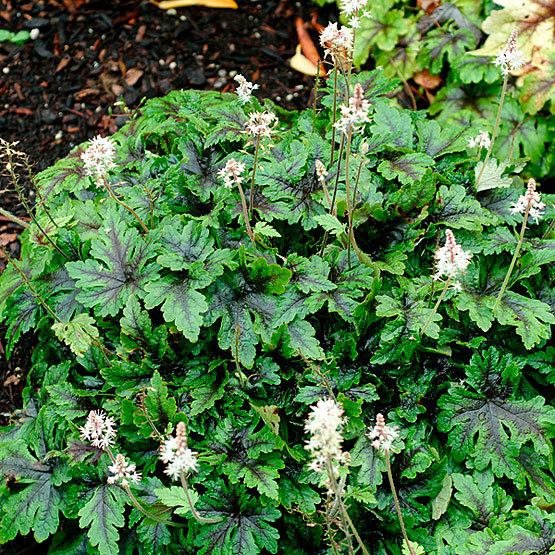
Plants in the genus Tiarella are at home in moist woodland environments of North America and East Asia. In the garden they form wonderful carpets of intricate leaves in a variety of shapes and with distinct markings. For a long period from spring into summer, the profusion of flowers can be appreciated up close or from a distance. Generally, running forms have smaller flowers than the semi-runners, and clumping forms have the showiest flowers.
There are around seven or eight accepted species of Tiarella. Two species are native to North America: eastern foam flower, or heart-leaved foam flower (Tiarella cordifolia, Zones 3–9), and three-leaved foam flower (Tiarella trifoliata, Zones 3–9). Eastern foam flower is native to the East Coast, north to Quebec and Ontario, south to Georgia, and as far inward as Minnesota. Three-leaved foam flower is native to the West Coast, from southern Alaska to Southern California, and inward to Montana.
Tiarella is closely related to Heuchera, and they are often bred together to form great hybrids called Heucherella.
Noteworthy CharacteristicsShort spikes of airy, star-shaped flowers form a foamy haze over the attractive, low-growing foliage. Flowers, which range from white to pink, bloom in spring. Foliage is lobed with striking veining. They are perfect for woodland gardens and are a great foil to early spring bulbs. They also make a great shade-garden container plant. There are both clumping and running forms of foam flower, and the latter will spread to form a ground cover.
CareThese plants prefer rich, well-drained soil but will tolerate a variety of soil types with neutral pH. Soil should be evenly moist but well-draining. Soggy soil will cause root rot. When foam flowers are grown in the right soil, fertilizer is not necessary; however, they are heavy feeders when grown in containers. While they can tolerate full shade, they prefer partial shade with dappled sunlight. Avoid exposing them to afternoon sun. They don't need to be divided to maintain their performance.
PropagationMany species are self-sterile and require a different species or cultivar to form fertile seed. Seed can be collected when the brown seedpods burst open in summer. It can then be sown immediately. Seedlings will form by fall, which may need to be protected over the winter. Seed can also be saved to sow later. Foam flower can be easily divided. These plants spread by stolons, and stolons can be cut off and replanted or put in water to help them form roots before replanting.
ProblemsFoam flowers may suffer from rust or powdery mildew. They are not commonly affected by pests, but the pests that can prey on them include slugs, black vine weevils, mealy bugs, and foliar nematodes. The most dangerous of these are black vine weevils. An infestation of these will eventually kill the affected plant, and these pests can only be controlled with insecticides. Foam flowers are not the first choice of deer or rabbits, although nothing is totally deer-proof.




























